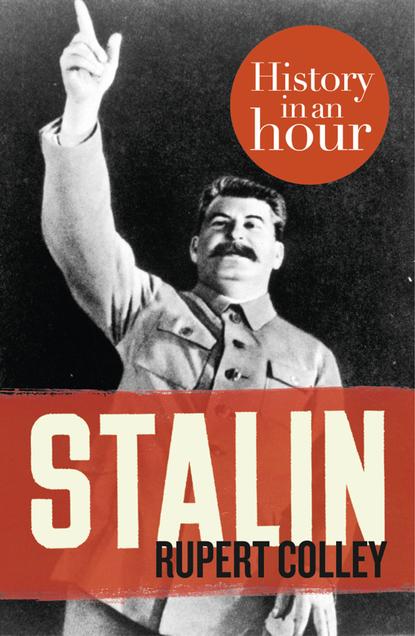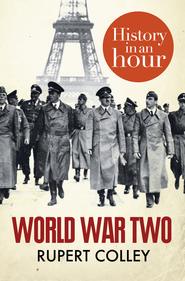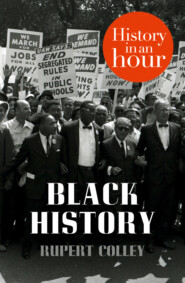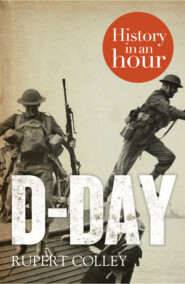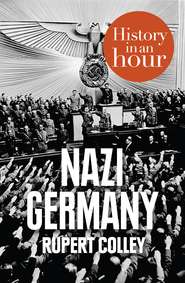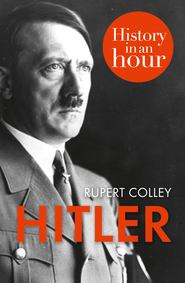По всем вопросам обращайтесь на: info@litportal.ru
(©) 2003-2024.
✖
Stalin: History in an Hour
Настройки чтения
Размер шрифта
Высота строк
Поля
Stalin married his first wife, the devout Ekaterina Svanidze, nicknamed Kato, in 1906. To appease his in-laws, Stalin agreed to marry in an Orthodox church. Together they had a son, Yakov, born 18 March 1907, but with Stalin so often absent, busy inciting unrest, his wife and son saw little of their wandering revolutionary. Kato died of typhus in December 1907. She was 22. At her funeral, which, again, Stalin allowed to take place in an Orthodox church, he reputedly said, ‘this creature softened my heart of stone. She’s died and with her have died my last warm feelings for humanity.’ He ignored his son, who was brought up by the Svanidzes. In later years, Stalin ordered the arrest and execution of much of Kato’s family, including, in 1941, her brother, Alexander Svanidze, an old school friend of Stalin’s, who, thirty-five years before, had introduced him to his sister.
In 1907, Stalin participated in the political unrest in the Caspian port of Baku in Azerbaijan. Although he later exaggerated his role in Baku, he was certainly involved in organising strikes and producing a workers’ newspaper, for which he was again arrested, imprisoned and exiled east. A few years later in 1911, Stalin fathered a son by his landlady, Maria Kuzakova, while living in the isolated village of Solvychegodsk. The boy, called Konstantin, never had any contact with Stalin and in 1932 was forced into signing a statement agreeing not to reveal the identity of his father. He was arrested in 1947, accused of being an US spy, but soon released, very likely on the orders of Stalin.
Stalin aged 33, 1912
The RSDLP split into two factions in 1903 – Bolshevik and Menshevik. Stalin, an admirer of the writings of the lawyer and revolutionary, Vladimir Lenin, allied himself to the Bolshevik cause. His work at undermining the Mensheviks within Georgia and his involvement in a number of bank robberies in Tiflis to raise funds for the Bolsheviks, brought him to Lenin’s attention. He first met the Bolshevik leader on 7 January 1906 at a party conference in Tampere, Finland.
Lenin was impressed with Stalin, calling him the ‘wonderful Georgian’. Lenin appointed him to the Bolshevik Central Committee in 1912, although this had to be carried out in absentia as Stalin was serving a jail sentence. It was about this time that Stalin dropped his Georgian alias, Koba, and adopted instead the name Stalin. His birth name, Dzhugashvili, gave away his Georgian roots and was too difficult for his Russian colleagues to pronounce. The Bolsheviks were keen on their tough-sounding pseudonyms: ‘man of steel’ for Stalin; ‘man of stone’ for Lev Kamenev; ‘the hammer’ for Vyacheslav Molotov.
Revolutions and Civil War (#ulink_0e616de7-3aea-51a6-821b-d6360392fb42)
The outbreak of the First World War in July 1914 accelerated the collapse of Tsar Nicholas II’s rule. Defeat on the Eastern Front, the loss of large swathes of Russia’s western territory to Germany, food shortages and economic hardship took its toll on Russia’s fragile infrastructure.
The February Revolution
In early March (late February by the Old-Style Julian Calendar), strikes broke out in Petrograd – the Tsar renamed St Petersburg to the less Germanic-sounding Petrograd in August 1914. Much of the population took to the streets and demonstrators formed councils of workers, or ‘Soviets’. On 15 March, former members of the Duma, Russia’s parliament, formed a Provisional Government. On the same day, Nicholas II was forced to abdicate. After 304 years, the Romanov dynasty was no more. The Tsar and his family were kept in various safe houses and were at Yekaterinburg in the Urals when Lenin finally ordered their murder on the night of 17 July 1918.
Together, in an uneasy alliance, the Provisional Government and the Soviets – comprising mainly Mensheviks and Socialist Revolutionaries – ran the country. This dual power was necessary as the Government needed the support of the Soviets, and the Soviets felt unprepared to take on full power.
Stalin, in common with all leading Bolsheviks, missed the February Revolution. He was still living in Siberian exile. He returned to Petrograd on 12 March with his friend Lev Kamenev, wearing the same suit in which he was arrested four years earlier. He lodged with the Alliluyevs, a family he had known since 1904, when he first met the two-year-old Nadya, his future wife. Stalin, it was said, saved the infant from drowning. He may have had an affair with Olga Alliluyeva, his future mother-in-law. Now, in 1917, the sixteen-year-old Nadya was attracted to the thirty-eight-year-old daring revolutionary with his sweep of jet-black hair. Two years later, in 1919, the couple would be married.
Now resident in Petrograd, Stalin took over the editorship of the Bolshevik newspaper, Pravda (‘Truth’), from Vyacheslav Molotov. Molotov had used Pravda to criticise the Provisional Government which many in the Bolshevik party saw as little better than the autocratic Tsar it had replaced. But the Bolsheviks were a minority party, even within the Soviets, and Stalin, in an attempt to augment the Party’s standing, advocated a degree of cooperation with the Provisional Government. In April, Lenin returned from exile in Switzerland. Mocking the February Revolution and condemning the new government as ‘imperialistic through and through’ he censured Stalin for his conciliatory attitude towards it.
Vladimir Lenin, 1920
Stalin took heed and, in a rare occurrence, offered an apology. Throwing his full support behind Lenin, he toughened his stance not only against the Government but against other socialist parties.
In July, demonstrations against the Provisional Government broke out in Petrograd. The Bolsheviks, feeling the time was not yet ready for an uprising, distanced themselves from the ‘July Days’ demonstrators. Leon Trotsky and other leading Bolsheviks were arrested – but not Stalin, who was considered of little importance. Stalin hid Lenin in the Alliluyev home and, advising Lenin to shave off his trademark beard, helped him disappear into hiding – first into some woods outside the city, then into Finland.
In late October, Lenin returned to Petrograd and urged an immediate seizure of power. He was opposed by two leading Bolsheviks, Lev Kamenev and Grigory Zinoviev, who advised restraint. Surprisingly, Stalin sided with the moderates and even argued their case to Lenin, threatening to resign his position as editor of Pravda. Lenin, angered at this reticence, pressed on. On 23 October at a meeting of the Bolshevik Party Centre Committee in Petrograd, the party voted ten to two that, ‘an armed uprising is inevitable, and that the time for it is fully ripe’. Stalin, bruised from his altercation with Lenin, was among the ten.
The October Revolution
On 7 November (25 October Old Style) the Bolsheviks’ armed wing, the Military Revolutionary Council, commanded by Trotsky, took control of Petrograd, then overran the Winter Palace, overthrowing the Provisional Government. The Soviets had obtained power. Lenin then ensured that the Mensheviks and Socialist Revolutionaries were sidelined and that effective power lay in the hands of the Bolsheviks only. Lenin then instituted the new government, the Council of People’s Commissars, abbreviated as Sovnarkom. Trotsky was made the People’s Commissar for Foreign Affairs, and Stalin, by dent of being a Georgian, was appointed the People’s Commissar of Nationalities, established specifically to ensure that the former tsarist empire remained as one, resisting the demands for national self-determination.
Civil War
The Bolsheviks’ hold on power was tenuous. Across Russia, groups opposed to Lenin’s new autocracy joined forces to oppose by violent means the Bolshevik government. This jumbled alliance of ex-tsarist officers, monarchists, disillusioned socialists, and various ethnic groups – collectively the ‘Whites’, had nothing in common but its shared hatred of the Bolsheviks. As the Russian Civil War broke out, Stalin was appointed as a Political Commissar leading the defence of the city of Tsaritsyn (renamed Stalingrad in 1925 and now called Volgograd).
Stalin aged 40, 1918
Stalin frequently clashed with Leon Trotsky, his military superior and recently appointed the People’s Commissar for Military and Naval Affairs. Trotsky – who deservedly took much of the credit for winning the ‘Reds’ the Civil War – exploited the expertise and experience of former officers of the Tsar’s army, holding their families hostage to ensure their active participation. Stalin, who had no truck with anything related to tsarism – preferring to have them shot – devoted as much energy to fighting Trotsky’s supporters as the Whites. He once, infamously, imprisoned a group of Trotskyites on a leaky barge on the River Volga and left them to drown.
Stalin’s rise through the ranks of the Communist Party (the Bolshevik party had changed its name to the Russian Communist Party in March 1918) and onto ultimate power was impressive. He owed it all to the support of Lenin who, in March 1919, appointed him to both the five-man Politburo, responsible for policy, and to the Orgburo ‘organisational bureau’, which dealt with administrative matters and party personnel – such as appointing managers of regional party branches. It was in this latter role that Stalin’s methodical organisation and indexing of members earned him the contemptuous nickname Comrade Card Index. But in their facetiousness, his rivals underestimated one of Stalin’s strengths – he got to know the blemishes on everyone’s records and, never one to forget a name, exploited this information to full effect. The top promotion came in April 1922, when Lenin, acting on a proposal put forward by Kamenev and Zinoviev, made Stalin General Secretary of the Communist Party’s Central Committee, a post he held until 1952, a year before his death.
Stalin, Lenin and Trotsky (#ulink_db39bf41-7a6e-5e32-be6d-252c1d76b5ca)
Lenin soon regretted his haste in over-promoting Stalin, falling out with his General Secretary over the latter’s handling of Georgia. Originally, the Bolsheviks had promised the Russian nations self-determination but, once in power, they reneged on that promise, wanting to keep all nations of the former Russian Empire within the Soviet orbit.
Stalin and Lenin, March 1919
The Civil War had intensified these hopes and Georgia had enjoyed a brief spell of independence from May 1918 until February 1921 when the Red Army re-asserted Moscow’s control. Lenin advised a conciliatory approach, advice that Stalin, along with his fellow countryman, Sergo Ordzhonikidze, ignored by imposing a crackdown on Georgian autonomy and executing its leaders in 1922.
Lenin’s Testament
Lenin was furious with his ‘wonderful Georgian’ but in May 1922 he suffered the first of three strokes, greatly diminishing his ability to maintain command. In December 1922, Lenin wrote his Testament, in which he commented on individual members of the Party’s Central Committee. His most damning judgement was reserved for his General Secretary, whom he described as having ‘unlimited authority concentrated in his hands … I am not sure whether he will always be capable of using that authority with sufficient caution’. Stalin’s bullish behaviour in Georgia was Lenin’s case-in-point. More damning still for Stalin was Lenin’s addendum to his Testament, written ten days later, in which he declared:
‘Stalin is too rude and this defect, although quite tolerable in our midst and in dealing among us Communists, becomes intolerable in a Secretary-General. That is why I suggest the comrades think about a way of removing Stalin from that post and appointing another man in his stead who in all other respects differs from Comrade Stalin in having only one advantage, namely, that of being more tolerant, more loyal, more polite, and more considerate to the comrades, less capricious, etc.’
Although the Central Committee had made Stalin their main contact with Lenin during his illness, the doctors had agreed that Lenin should be permitted no visitors. Stalin began to suspect, correctly, that Lenin’s wife, Nadezhda Krupskaya, whom Stalin had never liked, was feeding her husband pro-Trotsky and anti-Stalinist information. On 22 December, Stalin telephoned Krupskaya, called her a ‘syphilitic whore’ and, in her words, ‘subjected me to a storm of the coarsest abuse’. Krupskaya was a resilient woman but Stalin’s tirade reduced her to a nervous wreck. Stalin was unrepentant: ‘just because she uses the same toilet as Lenin doesn’t mean she understands Marxism–Leninism’. Lenin didn’t find out about the call until three months later and when he did, he wrote a letter to Stalin:
You have been so rude as to summon my wife to the telephone and use bad language ... what has been done against my wife I consider having been done against me. I ask you, therefore, to think it over whether you are prepared to… make your apologies, or whether you prefer that relations between us should be broken off.
The next day, 6 March 1923, Lenin suffered his third stroke, which left him bedridden and mute. He died ten months later, on 21 January 1924, aged fifty-three.
Stalin visits Lenin during Lenin’s convalescence
Krupskaya remained a thorn in Stalin’s side, demanding that Lenin’s Testament be read out, as her husband had wished, at the forthcoming Thirteenth Party Congress, due in May 1924. Determined to suppress it, Stalin silenced her by threatening to find Lenin a ‘new widow’; Krupskaya was to die, a frightened woman, aged seventy in 1939.
Stalin took the lead in organising Lenin’s funeral and appeared as the chief pallbearer. Trotsky, who was recovering from illness near the Black Sea, missed the funeral – Stalin having deliberately told him the wrong date. Stalin initiated the deification of Lenin, in which the great leader’s image was seen everywhere and his memory held in reverential terms. Within days of his death, Petrograd was renamed Leningrad. Stalin’s broken relationship with Lenin was quietly forgotten and he reinvented himself as the bearer of Lenin’s legacy. To doubt Stalin was to doubt Lenin and question the whole legitimacy of the Revolution.
Opposition
Kamenev and Zinoviev, motivated by their fear of the arrogant Trotsky, joined forces with Stalin and together the three men assumed unofficial leadership of the Party as a troika. Between them they managed to get the Central Committee to agree on suppressing Lenin’s Testament. Stalin had offered to resign over the issue. The committee, including Trotsky, rejected his offer. They would all pay dearly for their support.
Leon Trotsky
Trotsky and his supporters, labelled as the ‘Left Opposition’, opposed the party on many accounts and were attacked on all sides. Their views, ‘Trotskyism’, became a profanation of immense proportions. Stalin had on his side Kamenev, Zinoviev and Pravda editor Nikolai Bukharin, Lenin’s ‘favourite of the whole Party’.
Nikolai Bukharin
Stalin used his power to dismiss his perceived dissenters within the Party and replace them with loyal followers. In January 1925, Stalin was strong enough to force Trotsky’s resignation from his post of People’s Commissar for War.
Kamenev and Zinoviev felt that perhaps Lenin had been right after all – that Stalin had too much power. At the Fourteenth Party Congress in December 1925, Kamenev suggested that Stalin be removed from his position as General Secretary and that his accumulation of power was ‘harmful to the Party’. He received a hostile reception.
Вы ознакомились с фрагментом книги.
Приобретайте полный текст книги у нашего партнера:
Приобретайте полный текст книги у нашего партнера:





